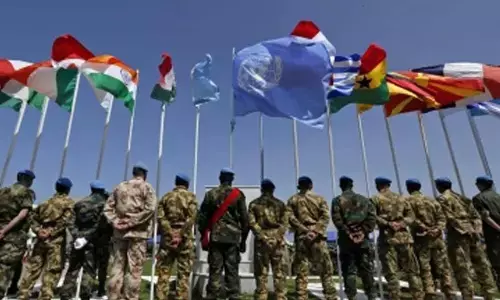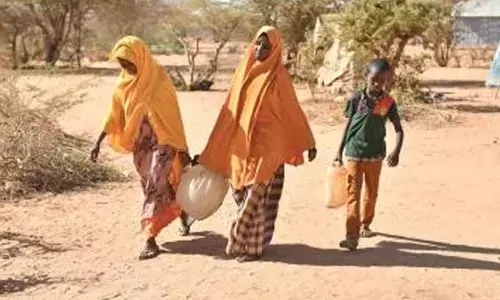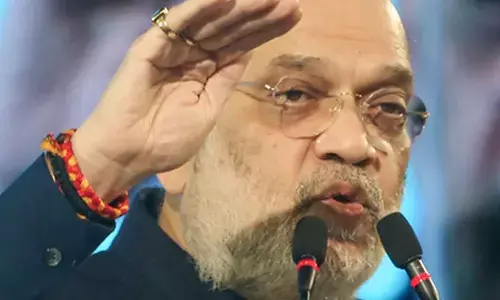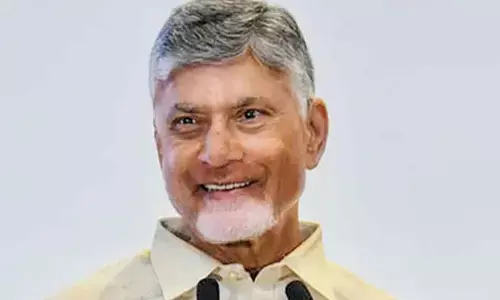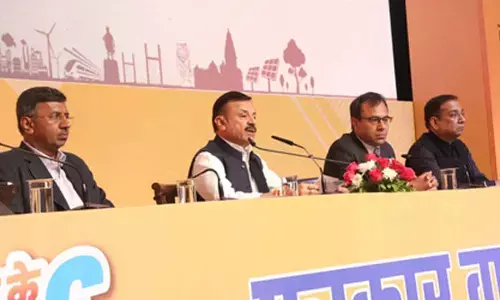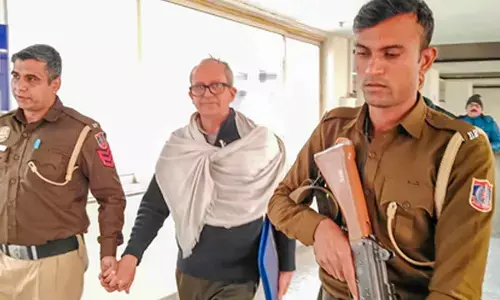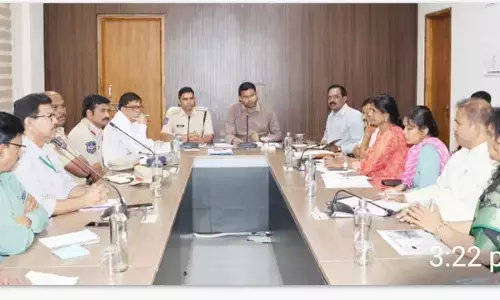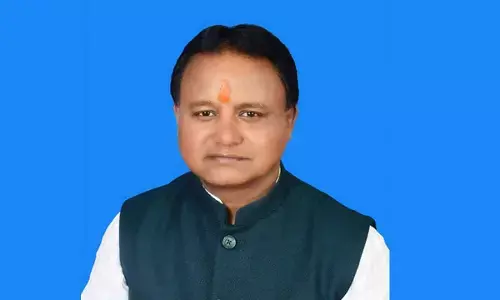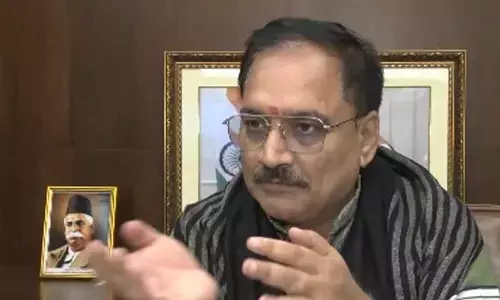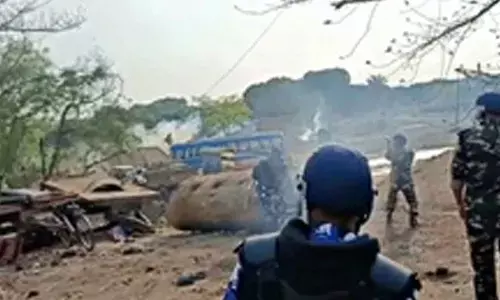The glory of Bhadradri Rama temple

The Glory of Bhadradri Rama Temple. The Sri Sitaramachandra Swamy temple at Bhadrachalam is thronged to by people from all over the country all around the year, particularly during Vaikunta Ekadasi and Sree Rama Navami.
The Sri Sitaramachandra Swamy temple at Bhadrachalam is thronged to by people from all over the country all around the year, particularly during Vaikunta Ekadasi and Sree Rama Navami. One of the most elevating legends attached to it is that in the 17th century a man called Kancherla Gopanna, popularly known as Ramadas, a true apostle of Rama, got it renovated at an estimated cost of Rs 6 lakh, and consecrated it to the Lord so that posterity may find bliss there.
.jpg)
He also secured a variety of ornaments made of gold and precious stones for the idols. Some of the ornaments like Kalikiturayi, Patchala Pathakam, Chintaku Pathakam, which were presented to Lord Rama and Sita Maha Lakshmi, are still preserved in the temple. Gopanna (Ramadas) was the nephew of Tanisha’s ministers Akkanna and Madanna, with whose help he got the post of Tahsildar of Bhadrachalam area. The serene calm of the temple, heightened rather than disrupted by the stammering waves of the Godavari, is propitious for God-realisation.
But the money spent by Ramadas was the revenue he had collected as Tahsildar under Qutb Shahi King Abul Hassan Tanisha without remitting it to the treasury. The king got him arrested and imprisoned him in the Golconda Fort and tortured him. Undergoing an arduous sentence, Ramadas prayed to Rama ardently, but in vain.
.jpg)
Dejected, Ramadas reprimanded Lord Rama for not helping him. He also appealed to Rama to convey his agony to Mother Sitamma with a request to save him with her gracious looks. After so severely testing his devotee, Lord Rama, accompanied by Lakshmana, appeared to Tanisha in his dream as a messenger from Ramadas and offered to reimburse him. Rama also procured a receipt from the king acknowledging the payment of money in the shape of gold coins. Thereupon, the king not only released Ramadas immediately but also restored his official position, and announced annual grants to the temple, a practice which was continued by the later Nizams. It was Bhakta Kabir who initiated Ramadas to ‘Rama Taaraka Mantra’. Thus it can be seen that this temple created communal harmony and emotional integration.
This pilgrim centre is reached by road and rail from both Hyderabad and Vijayawada. The Puranas offer a story on the origin of Bhadradri (a hill called Bhadra). In Treta Yuga, Bhadra offered itself as a resting place for Lord Rama. In the next birth he was born as a son to Meru and studied all the shastras under Vashista Maha Muni. Sage Narada initiated him to ‘Rama Taaraka Mantra’. He did penance and his aspiring soul caught a glimpse of Rama. He remained a staunch devotee of Rama till the end of Dwapara Yuga. And at the beginning of Kali Yuga, he manifested himself as a hill on the banks of the River Godavari near Papi Kondalu as the abode of Lord Rama and Sita Maha Lakshmi. Hence, the name Bhadradri.
The village around the foothill is called Bhadrachalam. This is the holy shrine of Sita-Ramachandra. Pokala Dammakka (some say Tammala Dammakka), a widow, who was a great devotee of Lord Rama, also deserves a mention. She had a daughter who was also a notable devotee of Rama. Lord Rama appeared to Dammakka in a dream and told her he was staying on Bhadragiri (Adri) without a shelter or worship and offerings. “Tell about my existence to the villagers and start poojas. In the due course, a devotee of mine will help you and he will build a marvelous temple for me and acquire ornaments.
By worshipping me, you will attain moksha.” Accordingly, Dammakka went to the hill accompanied by the villagers and searched the area and found the idols of Sita-Rama-Lakshmana at one place. She cleansed the idols and arranged a makeshift shelter for them with the help of the villagers. From then on they started regular worship of the idols and offered naivedya. With the help of the villagers and from the offerings of devotees she built a modest “mandap” and started bhajans.
The word spread about the incarnation of Rama and of Dammakka’s devotion. People started visiting the shrine in large numbers. Dammakka’s daughter was also steadfast in her worship of the idols. One day Dammakka went to a neighbouring village on some work, entrusting to her daughter the work of worshipping the deities and of offering naivedya. She went to the temple with the naivedya. The deity did not touch the naivedya when it was offered. Fear gripped her---fear of some defect in her way of worship and fear of her mother taking her to task. With child-like innocence she pleaded with the deity repeatedly to eat the naivedya, but in vain. In a fit of anger and disappointment she picked up a stone and hit her head repeatedly with it. It was a moving sight. Her innocence, deep devotion and entreaties moved the Lord. The very next moment Rama ate up all the naivedya.
.jpg)
Thanking the Lord for obliging her, she went home happily. When her mother returned from the village, she inquired if she had offered pooja and naivedya. Her daughter said that she had done as she had been advised. When she asked for the remaining prasadam, her daughter said that Rama had eaten up everything. Trusting her words, she prayed to the Lord for His grace. She earnestly inquired of Him why He was not so merciful to her. Rama appeared to Dammakka in a dream and told her that her daughter was very innocent and steadfast in her devotion. Rama blessed her and assured that another devotee would come and help her in her efforts and build a beautiful temple at that place. Rama foretold her about the coming of Ramadas. There is a special significance for the incarnation of Lord Vishnu on the earth as Sri Rama. Demon king Ravana practiced austerities so as to propitiate Brahma, who had granted him immunity from being killed by gods, gandharvas or demons.
Under the cover of this immunity and the benevolence of Shiva, whom he assiduously propitiated, Ravana harassed and tortured gods and mortals. The muchworried gods worked out a strategy to eliminate Ravana. It was resolved that a god should take human form to kill Ravana, for Ravana had been too proud to ask for immunity from humans. Lord Vishnu agreed to accomplish the task, and all other gods promised to lend their powers to humans and animals that would offer help to Rama.
Lord Vishnu was accordingly born on earth to king Dasaratha, who had, for many years, no children. He performed Ashwamedha (horse sacrifice ritual) aspiring for children. As a result, four sons were born to him. The eldest son, Ramachandra, was born to Kausalya; the second son, Bharata, to Kaikeyi; and two more sons, Lakshmana and Satrughna, to a third wife, Sumitra. Rama and Lakshmana were particularly close. Even as boys they killed many demons that were persecuting hermits. One day they heard that king Janaka’s charming daughter Sita was to be married.
Sita was actually an incarnation of Maha Lakshmi, Vishnu’s consort, and had received her name, meaning “furrow,” because she had been born of her own will in a field opened up by a plough. A contest was to be held and the man who could bend a bow given to Janaka by Shiva was to receive Sita’s hand. Sage Viswamitra took Rama and Lakshmana to the contest, and Rama was the winner by actually breaking the bow. Rama’s marriage with Sita was celebrated on a grand scale. This celestial wedding is celebrated every year in grand style at Bhadrachalam. Nearly five lakh devotees from all over the country throng to the shrine for the Kalyanotsavam year after year. This is what is known as Sri Rama Navami. The peculiarity of this festival is that Navami is the birthday of Sri Rama. His wedding is celebrated on that day.
One convincing explanation is that Sri Rama and Goddess Sita Maha Lakshmi cannot be worshipped separately; they are like Parvati and Parameshwara who are eternally united. So people celebrate the wedding first so as to worship the deities together. During Sree Rama Navami, Bhadrachalam looks like real heaven on earth. One should visit the shrine on the day to experience the sublime intensity of spirituality.
Y V RAMAKOTAIAH








